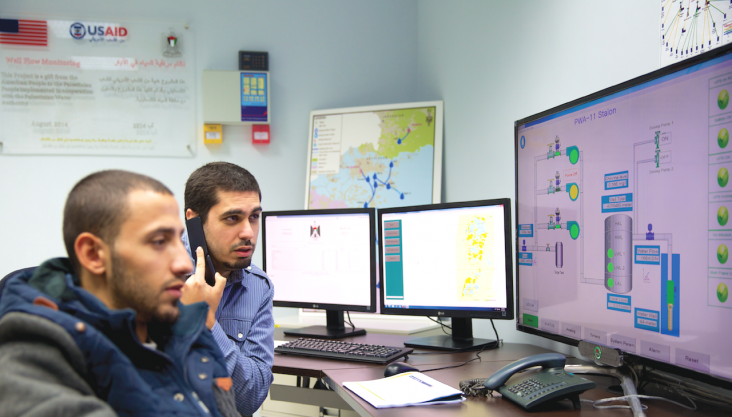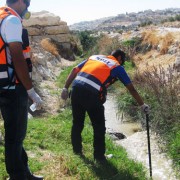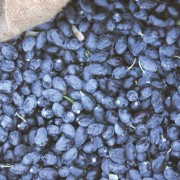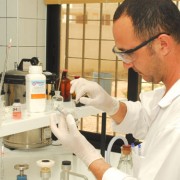 The remote terminal unit of a water monitoring system collects data from a well site in the West Bank.
Black & Veatch
The remote terminal unit of a water monitoring system collects data from a well site in the West Bank.
Black & Veatch
 The remote terminal unit of a water monitoring system collects data from a well site in the West Bank.
Black & Veatch
The remote terminal unit of a water monitoring system collects data from a well site in the West Bank.
Black & Veatch
Since 2000, USAID has implemented hundreds of water and wastewater activities in the West Bank and Gaza to improve reliable access to clean water for the Palestinian people. Work has included drilling new wells, rehabilitating pump stations, installing major bulk water transmission pipelines, constructing water reservoirs and connecting thousands of Palestinian homes to the water network.
All of these activities have centered on what can only be described as a precious commodity in the Middle East.
At present, due to water scarcity, as well as aging and leaking infrastructure, the 2.8 million Palestinians in the West Bank do not meet the World Health Organization recommendation of using 100 liters of water per person per day. Reliability of water delivery varies greatly throughout the West Bank. The best served areas receive some water every day; some residents receive water twice a week, and some locations receive water only once every 30 days during the dry summer. Unscheduled water service disruptions occur throughout the West Bank, leaving Palestinians without running water in their homes.
To complement its investments in water infrastructure in the West Bank, in 2014, USAID established a supervisory control and data acquisition (SCADA) monitoring system that tracks flow and production rates at 40 main water production wells, three booster stations and three reservoirs throughout the West Bank.
As part of the SCADA project, USAID installed electromagnetic flow meters and communications systems at 46 sites to enable data acquisition and transmission. With the help of 13 transmission towers throughout the West Bank, radio waves and microwaves transmit flow rate data in real time to the West Bank Water Department control room in Ramallah. The control room is equipped to receive, record, monitor and manage information from each site. Once in the control room, the data is automatically sorted and backed up.
This is the first time technology of this caliber has been introduced in the West Bank, and its impact on monitoring, efficient management and calculated planning of water resources distribution in the West Bank is momentous, officials say.
The long-term goal of the program is to safeguard investments and help the West Bank Water Department and Palestinian Water Authority better manage precious water resources. Improved water resource management in the West Bank will ultimately benefit all Palestinians.
Samir Tumah, the IT manager at the West Bank Water Department and the coordinator for the SCADA project at the Palestinian Water Authority, explains that flow rates are the most important piece of information needed to oversee and manage the Palestinian water sector.
Flow rate values indicate how much water is produced from West Bank wells, reservoirs and booster stations. West Bank Water Department experts review and analyze all the information pertaining to total flow rates and create customized reports they can use for water planning.
“The SCADA project is of vital importance, as it ensures the proper operation and monitoring of our water facilities,” said Khalil Ghabish, head of the West Bank Water Department.
Tumah noted that four of the 46 sites that are part of the SCADA project are equipped with full monitoring capabilities, providing data not only on flow rates, but also on electrical parameters, pressure values, water levels and chlorine levels. “The information from these sites can also help detect leaks. We can see whether the flow rates going to the reservoir match those being abstracted from the well. If they are not the same, we can identify the source of the leak and prevent unnecessary losses,” he said.
With water flow rate data from different locations throughout the West Bank, the SCADA program will help the West Bank Water Department and Palestinian Water Authority determine if and where there are leaks. Leak detection and prevention are crucial, as leaks from aging and deteriorating infrastructure—as well as from illegal connections—create water losses reaching up to 45 percent in the West Bank, estimated to cost the West Bank Water Department approximately $7.3 million per year. The SCADA system will provide the West Bank Water Department monitoring tools to help them better detect and fight losses for the facilities covered by the SCADA system. Eliminating losses can provide water equivalent to that produced from several new wells, and reduce financial burdens.
Thabet Hamayel, director of the Water Loss Department at the West Bank Water Department, noted that the project will help monitor water production quantity as well as produced and transmitted quantities of water, which will assist his department in identifying and minimizing lost water.
Based on the data and analyses, the West Bank Water Department can make decisions on what actions to take at specific well sites. In the case of leaks, for example, if West Bank Water Department employees determine that the infrastructure between the well and reservoir is faulty, they can decide to replace the pipe. This, in turn, will result in reducing water losses. As they say, every drop counts.
Data collected from each site also can enhance the ability of West Bank Water Department experts to plan how much water should be transmitted to each city, town and municipality in the West Bank. Prior to the establishment of the system, determining the exact amount of water that reached Palestinian cities and villages in the West Bank was not possible. With the SCADA system, water authorities are able to determine the amount of water that reaches each municipality, compare it to the number of residents, and determine whether there is a need to increase flow to a particular town.
“Not only will the project contribute to equitable water distribution in the West Bank, it will contribute significantly to water management and maintenance,” said Ghabish. In addition, the SCADA program can be expanded to encompass additional wells and reservoirs in the West Bank.















Comment
Make a general inquiry or suggest an improvement.